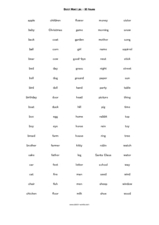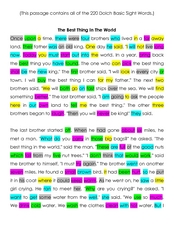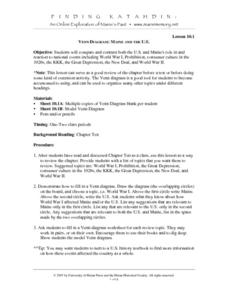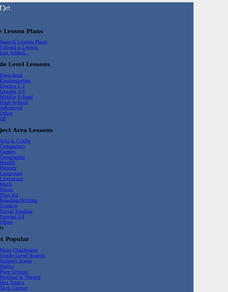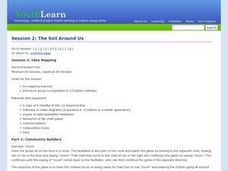EngageNY
Ptolemy's Theorem
Everyone's heard of Pythagoras, but who's Ptolemy? Learners test Ptolemy's Theorem using a specific cyclic quadrilateral and a ruler in the 22nd installment of a 23-part module. They then work through a proof of the theorem.
EngageNY
What Is a Trigonometric Identity?
Protect yourself from identity theft! Establishing a strong understanding of the Pythagorean identity allows learners to prove that sine^2x + cos^2x = 1. They then use the identity to find sine or cosine ratios given the other.
EngageNY
Experiments with Inscribed Angles
Right angles, acute angles, obtuse angles, central angles, inscribed angles: how many types of angles are there? Learners first investigate definitions of inscribed angles, central angles, and intercepted arcs. The majority of the...
EngageNY
What Is Area?
What if I can no longer justify area by counting squares? Lead a class discussion to find the area of a rectangular region with irrational side lengths. The class continues on with the idea of lower approximations and...
Pie Council
National π Day
Learners can enjoy pi with pie! A collection of short activities celebrates pi day with a word search, a maze, and real-world problemsn. Using pi in formulas for area, circumference, and volume as well as exploring simple fractions is...
EngageNY
Inscribed Angle Theorem and Its Applications
Inscribed angles are central to the lesson. Young mathematicians build upon concepts learned in the previous lesson and formalize the Inscribed Angle Theorem relating inscribed and central angles. The lesson then guides learners to prove...
EngageNY
Extending the Domain of Sine and Cosine to All Real Numbers
Round and round we go! Pupils use reference angles to evaluate common sine and cosine values of angles greater than 360 degrees. Once they have mastered the reference angle, learners repeat the process with negative angles.
EngageNY
Solving Area Problems Using Scale Drawings
Calculate the areas of scale drawings until a more efficient method emerges. Pupils find the relationship between the scale factor of a scale drawing and the scale of the areas. They determine the scale of the areas is the square of the...
Curated OER
Hidden Hundreds
This is a great puzzle like challenge for your advanced learners. They are given 5 problems to solve, they must show how many ways they can make to provided number using the given numbers in the box. For example: To make 800 they need to...
Curated OER
Venus Wordsearch
There are a ton of great vocabulary words to be found in a word search about the planet Venus. Learners will locate and circle 34 wonderful words related to planetary science and the solar system. Printing instructions are included.
Curated OER
Alphabet Letters S, T, U and V
Primary readers look at nine pictures and choose which letter, S, T, U or V begins each picture. Students circle their answers. This instructional activity is a great way for them to practice their phonemic awareness and letter recognition.
Curated OER
95 Nouns
A list of 95 nouns provides a great example to define nouns for your class. They can keep this at their desks for reference. Also, you can cut the list into strips to keep in a "noun jar," or have kids circle their favorite ones! This...
Curated OER
Flash Fractions 3
Love this! Kids play to practice determining which fraction is larger. Each set of fractions are represented in numeric form as well as how they appear on a fraction circle. This is a great way to show learners the differences between...
Curated OER
Dolch Words in a Story
After studying all of the 220 Dolch basic sight words, your class can read this great short story that includes every word. You can have your readers circle each sight word as they go.
Little Book Lane
"Sh" Words
Sh, sh, sh! When two letters together always make the same sound, they're called a consonant digraph. Get those early readers ready to use the sh sound with confidence. This packet contains printable wall cards, a...
Music Fun
Musical Instruments
Membranophones? Aerophones? How about strings? Percussion? You need not be a music instructor to benefit from a packet of 24 worksheets that introduce aspiring musicians to the various instrument families.
Curated OER
Venn Diagram: Maine And the U.s.
Middle schoolers compare and contrast major events in U.S. histroy using a Venn diagram. They focus on how the events affected their state and the country as a whole. Events expolred include World War I, the Great Depression,...
Curated OER
Interpreting Data and Statistics
Students define random sample and complete surveys. In this algebra lesson, students create surveys and define the way people analyze these results. They discuss random sample as it relates to the Great Depression and come up with their...
Curated OER
Surface area of a cylinder
Students construct a cylinder made of paper with detachable bases. Then they are taught the formulas for finding the area of a curved surface and the total surface area of a cylinder. A great hands-on approach!
Curated OER
I've Got a Friend
Students participate in an introduction activity. In this ice breaker lesson, students sit in a circle and the teacher sings a rhyme, calling a specific students to the middle of the circle. The students called must make silly faces,...
Curated OER
Rulers For a Day
Students design and create foil coins with images that symbolize students' imaginary leadership in the ancient world. They model their coins on those made for Alexander the Great. They discuss what made him an important historical figure.
Curated OER
Idea Mapping
Students generate, share and display ideas as a group. They break into small groups to work on hand-drawn maps made up of concentric circles. they come before the group and make a similar diagram by charting each other's characteristics.
Curated OER
Synonyms
In this synonym worksheet, 3rd graders will read a definition of the word synonym. Then students will read a sentence and circle the word in parentheses that has almost the same meaning as the underlined word in the sentence.
Curated OER
On the Road
In this visual thinking worksheet, 1st graders read and analyze a road map in order to circle the 5 multiple choice answers to 5 questions relating to the road map.











